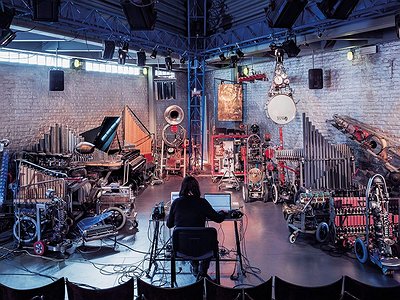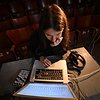Part 1
Name: Leonardo Barbadoro
Nationality: Italian
Occupation: Composer
Current Release: Leonardo Barbadoro's Musica Automata is out via Helical.
If you enjoyed this Leonardo Barbadoro interview and would like to stay up to date with his music, visit him on Soundcloud.
Technology has continually taken on more steps of the compositional process and "creative" tasks. From your point of view, where does "technology" end and "creativity" begin?
I was born in the 80s and technology was already largely part of the musical creative process. So since I was very young it has always been natural to use technological tools to make music.
In my case technology has never really taken on creative tasks. It simply offers me tools to broaden my compositional palette.
Are you finding that your work with robots is more and more embedded into a wider conversation about what “being human” truly means? What are your own thoughts on this topic on and beyond music?
Using robots was like somehow having an extension of my limbs. I had no deeper reflections on the meaning of "being human" while working on this project.
The reflections while I was working on the project were more on concepts related to the physics of sound and how it is generated and propagates in the acoustic space. I often find it so fascinating that it seems like something magical to me, especially if, as in this case, the sound waves coming from acoustic instruments playing in a real space are controlled by a computer without any human physical movement.
I reflect on the concept of the meaning of "being human" very often, almost daily I would say. But that's a pretty deep question, which I'm not sure I can adequately answer right now.
The press release makes several intriguing statements about the motivations and ideas behind the project – control, resonance, the uniqueness of sonic events, and more. I was curious which of these was at the heart of your work – is it more about giving the composer the ability to realise his vision down to the tiniest detail or the details themselves as made possible by this particular performance?
I would say both. The control of details on the performance certainly was one of the first motivations that enthralled me to make this record. But it’s also true that the particular characteristics of these instruments influenced the composition and therefore strongly conditioned the final result.
By particular characteristics I mean some specific features of these robots to go beyond the limits that a human performer would have when playing a certain instrument.
Talking about human versus machinal performance, the press release mentions that “musicians perform the score by translating signs into actions. In this scenario, an ineliminable gap emerges between the author's concept and the sound event.” That said, this gap allows for each performance to be different and a response to the moment – why would that be a bad thing?
That's certainly not necessarily a bad thing. But it depends on whether we are talking about a musician who wants to interpret a piece by deliberately adding variables to the performance, or whether these are random variations, far from what the composer wanted to achieve.
Maybe I'm too much of a control freak, but I think the desire of many other composers is to be able to translate a certain musical phrase into sound exactly as they imagined it. Of course, sometimes certain mistakes can turn into happy accidents, but these are exceptions. A certain percentage of randomness can still be used in the performance with robots. But in this case, it can be introduced only in a certain event, where you actually want to add this random component and not by accident.
And anyway, a very small random component is still present in the performance with the robots: a string or a skin struck will never sound exactly the same for physical reasons (air density, temperature, thinning of materials, etc. etc.). These are minimal variations that our ear perceives unconsciously and are those that actually make us distinguish an acoustic instrument from a digital sample.
Could you expand a bit on the important consideration that machines are actually physically playing the instruments?
The most important consideration is that they are real acoustic instruments that play in a real space. As I was saying, when sound propagates in an acoustic space it is subject to many variables which always make it slightly different and therefore for many less boring to our ear. This aspect is also sought after by many electronic musicians who use various tools to overcome the "problem" of a digital sample that is constantly repeated identical to itself.
For example, many people use samplers with round robin playback features (a sample switching when a single key is struck repeatedly) or simply break up audio loops along the transients and play the various fragments always in a slightly different order. But these are still samples and not a real acoustic instrument played, which is something very different both from a perceptual, sonic and executive point of view.
If I want to do something slightly similar with an electronic sound, then perhaps I find it more interesting to use re-amping techniques, compared to commercial digital sample libraries which use round-robin techniques. I’m not saying that the acoustic instrument is "better" than the sampler though, they're simply two different things.
In which way was writing the score to the music different this time? What were some of the things you could do here that might otherwise have been impossible?
Writing the score was quite different than usual because in addition to being electronic instruments, they are also acoustic and, above all, mechanical. So it's a bit more complex than controlling a hardware digital synthesizer with a MIDI input port.
Certainly there are several things that would have been impossible to achieve with traditional tools. I think that when most people read "overcoming the limits of the human performer", they think first of all about the speed of execution as it is the most obvious aspect, but in my opinion also the least interesting from a compositional point of view.
There are many other limits imposed by our physiognomy beyond the speed of execution, such as fingerings in wind instruments or simply the limit of having only 10 fingers available to play a piano with 88 keys. There are also limitations given by the tempered system of the instruments, as well as simply the limits in the frequency range that some of these robots can exceed.
I am aware that some people listening to the album may think that the same music could easily be performed by human performers with traditional instruments, but this is not the case. I deliberately chose not to surprise the listener with particular virtuosities, but rather I made these performance possibilities (and also limitations) the means for composing the music.
In many pieces there are frequencies outside the tempered system and phrasings that are impossible for a musician to play. These instruments also have many particular features, such as frequency domain filters, which make it possible to have tone quality that is very different from what could be obtained with a traditional instrument.
At the same time a human musician can do certain things more intuitively with an acoustic instrument and perhaps with more expressive results. I didn't make this record to demonstrate how robots can be better performers than humans. These robots are simply something else than usual acoustic instruments and using them to faithfully imitate a musician wouldn't make sense to me. Just as, in my opinion, it doesn't make much sense to use a synth to mimic a violin.
Exactly for this reason I decided to record the robots as they are, also with their mechanical noises and reverberations in the environment in which they play. Just as you can hear a performer breathing or the rubbing of his fingers on a string instrument during a recording or concert - it’s just a part of the performance.






